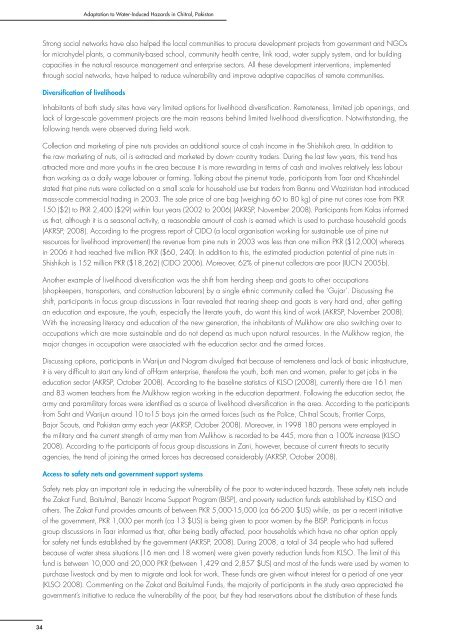Full Document - Himalayan Document Centre - icimod
Full Document - Himalayan Document Centre - icimod
Full Document - Himalayan Document Centre - icimod
Create successful ePaper yourself
Turn your PDF publications into a flip-book with our unique Google optimized e-Paper software.
Adaptation to Water-Induced Hazards in Chitral, PakistanStrong social networks have also helped the local communities to procure development projects from government and NGOsfor microhydel plants, a community-based school, community health centre, link road, water supply system, and for buildingcapacities in the natural resource management and enterprise sectors. All these development interventions, implementedthrough social networks, have helped to reduce vulnerability and improve adaptive capacities of remote communities.Diversification of livelihoodsInhabitants of both study sites have very limited options for livelihood diversifi cation. Remoteness, limited job openings, andlack of large-scale government projects are the main reasons behind limited livelihood diversifi cation. Notwithstanding, thefollowing trends were observed during fi eld work.Collection and marketing of pine nuts provides an additional source of cash income in the Shishikoh area. In addition tothe raw marketing of nuts, oil is extracted and marketed by down- country traders. During the last few years, this trend hasattracted more and more youths in the area because it is more rewarding in terms of cash and involves relatively less labourthan working as a daily wage labourer or farming. Talking about the pine-nut trade, participants from Taar and Khashindelstated that pine nuts were collected on a small scale for household use but traders from Bannu and Waziristan had introducedmass-scale commercial trading in 2003. The sale price of one bag (weighing 60 to 80 kg) of pine nut cones rose from PKR150 ($2) to PKR 2,400 ($29) within four years (2002 to 2006) (AKRSP, November 2008). Participants from Kalas informedus that, although it is a seasonal activity, a reasonable amount of cash is earned which is used to purchase household goods(AKRSP, 2008). According to the progress report of CIDO (a local organisation working for sustainable use of pine nutresources for livelihood improvement) the revenue from pine nuts in 2003 was less than one million PKR ($12,000) whereasin 2006 it had reached fi ve million PKR ($60, 240). In addition to this, the estimated production potential of pine nuts inShishikoh is 152 million PKR ($18,262) (CIDO 2006). Moreover, 62% of pine-nut collectors are poor (IUCN 2005b).Another example of livelihood diversifi cation was the shift from herding sheep and goats to other occupations(shopkeepers, transporters, and construction labourers) by a single ethnic community called the ‘Gujar’. Discussing theshift, participants in focus group discussions in Taar revealed that rearing sheep and goats is very hard and, after gettingan education and exposure, the youth, especially the literate youth, do want this kind of work (AKRSP, November 2008).With the increasing literacy and education of the new generation, the inhabitants of Mulkhow are also switching over tooccupations which are more sustainable and do not depend as much upon natural resources. In the Mulkhow region, themajor changes in occupation were associated with the education sector and the armed forces.Discussing options, participants in Warijun and Nogram divulged that because of remoteness and lack of basic infrastructure,it is very diffi cult to start any kind of off-farm enterprise, therefore the youth, both men and women, prefer to get jobs in theeducation sector (AKRSP, October 2008). According to the baseline statistics of KLSO (2008), currently there are 161 menand 83 women teachers from the Mulkhow region working in the education department. Following the education sector, thearmy and paramilitary forces were identifi ed as a source of livelihood diversifi cation in the area. According to the participantsfrom Saht and Warijun around 10 to15 boys join the armed forces (such as the Police, Chitral Scouts, Frontier Corps,Bajor Scouts, and Pakistan army each year (AKRSP, October 2008). Moreover, in 1998 180 persons were employed inthe military and the current strength of army men from Mulkhow is recorded to be 445, more than a 100% increase (KLSO2008). According to the participants of focus group discussions in Zani, however, because of current threats to securityagencies, the trend of joining the armed forces has decreased considerably (AKRSP, October 2008).Access to safety nets and government support systemsSafety nets play an important role in reducing the vulnerability of the poor to water-induced hazards. These safety nets includethe Zakat Fund, Baitulmal, Benazir Income Support Program (BISP), and poverty reduction funds established by KLSO andothers. The Zakat Fund provides amounts of between PKR 5,000-15,000 (ca 66-200 $US) while, as per a recent initiativeof the government, PKR 1,000 per month (ca 13 $US) is being given to poor women by the BISP. Participants in focusgroup discussions in Taar informed us that, after being badly affected, poor households which have no other option applyfor safety net funds established by the government (AKRSP, 2008). During 2008, a total of 34 people who had sufferedbecause of water stress situations (16 men and 18 women) were given poverty reduction funds from KLSO. The limit of thisfund is between 10,000 and 20,000 PKR (between 1,429 and 2,857 $US) and most of the funds were used by women topurchase livestock and by men to migrate and look for work. These funds are given without interest for a period of one year(KLSO 2008). Commenting on the Zakat and Baitulmal Funds, the majority of participants in the study area appreciated thegovernment’s initiative to reduce the vulnerability of the poor, but they had reservations about the distribution of these funds34
















